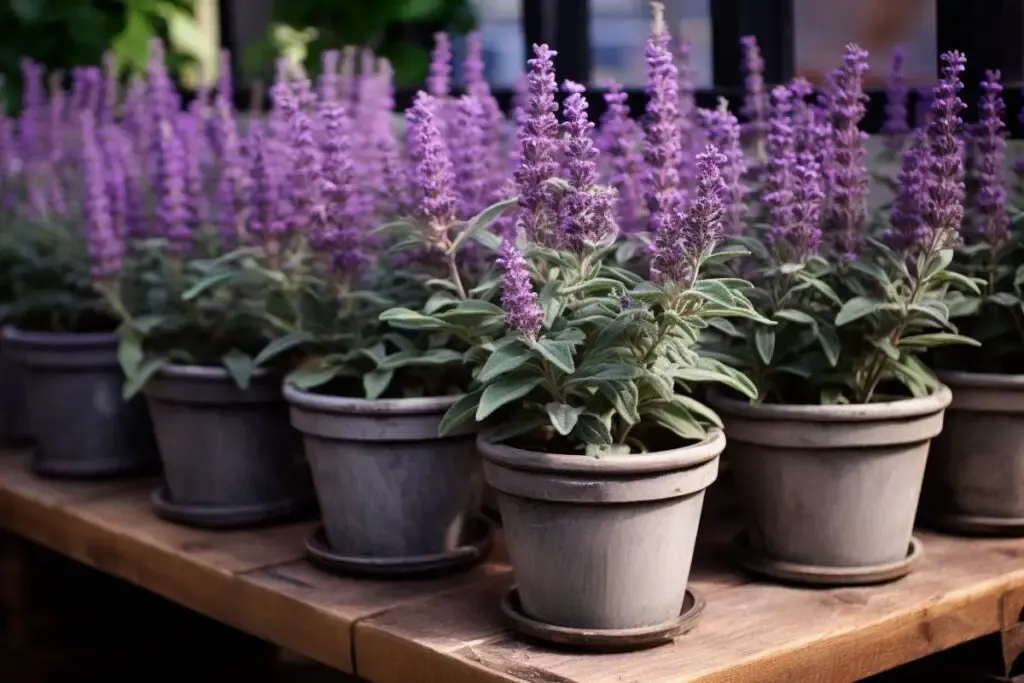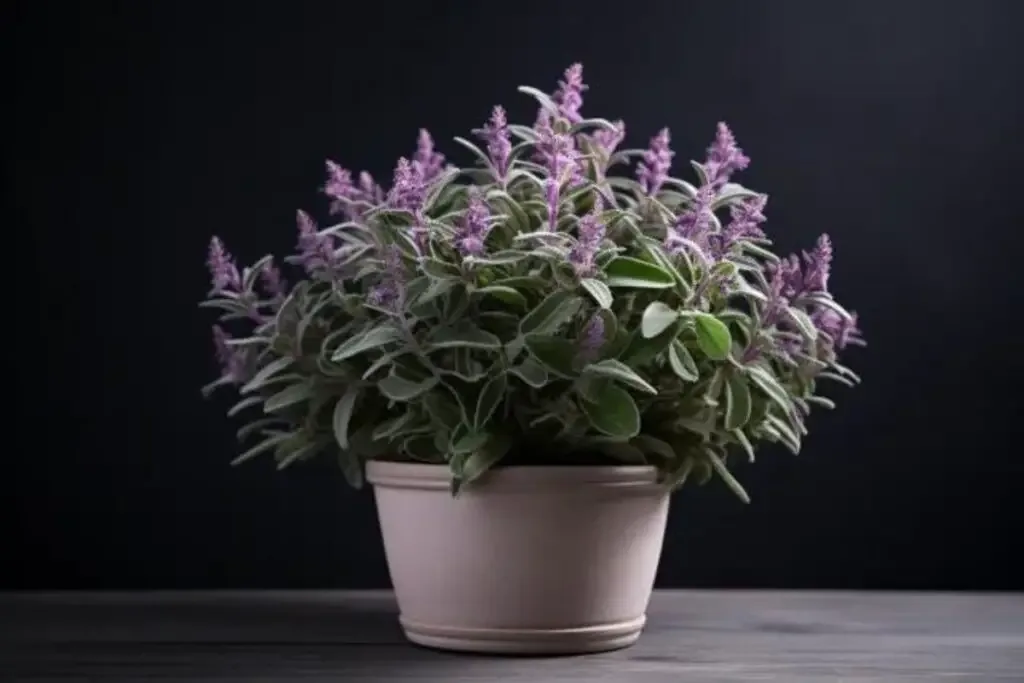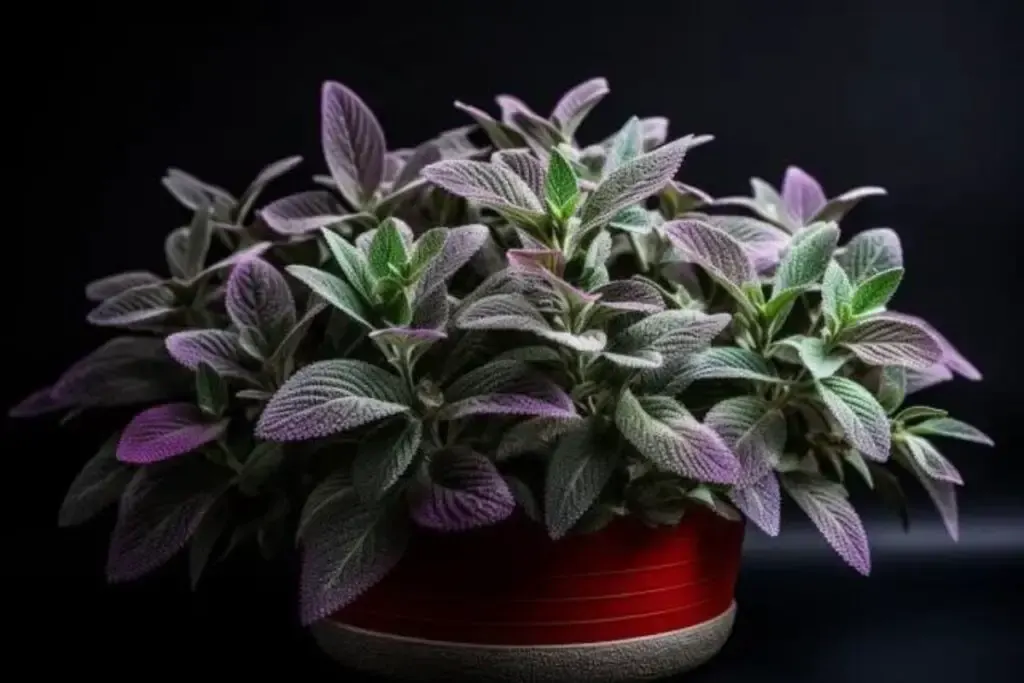Gardening enthusiasts often overlook the humble sage plant, yet this aromatic herb brings both culinary zest and ornamental value to any space.
Growing sage in pots is an exceptional way to enjoy this versatile plant, particularly for those with limited garden space or who wish to keep their herbs close at hand in the kitchen or on a sunny windowsill.
Does Sage Grow Well in Pots?
Sage is a hardy perennial that takes well to container gardening. Its drought tolerance and preference for well-draining soil make it ideally suited for the environment pots provide.
When grown in pots, sage can be conveniently placed where it receives the right amount of sunlight, and its growth can be easily managed. Moreover, potted sage can be protected from extreme weather conditions, making it a perfect candidate for year-round cultivation.
As an expert gardening blogger, I’ve seen many a plant thrive in the confines of a container, and sage is no exception. Its compact root system doesn’t require vast space to spread, making it an ideal choice for pot cultivation. With the right pot size, adequate drainage, and proper care, your potted sage can flourish and provide a fresh supply of this fragrant herb throughout the seasons.
Best Sage Varieties for Pots
Not all sage varieties are created equal, especially when it comes to container gardening. While most sage plants will perform well in pots, some are more suited to the confines and particular conditions of container life.
1. Garden Sage

Garden Sage, also known as Common Sage or Culinary Sage, is the most popular variety for cooking and is incredibly well-suited to pot growing.
This variety is characterized by its grey-green leaves and woody stems, making it a hardy addition to your potting collection. It’s the go-to herb for stuffing and meat dishes, and its pleasant aroma makes it a delightful plant to have within arm’s reach.
When grown in pots, Garden Sage requires minimal care. A tip from personal experience: do not overwater and ensure the pot has ample drainage holes. This plant loves the sun, so a south-facing window or a spot on the balcony that receives full sun is ideal.
2. Purple Sage

Purple Sage is a stunning variety that offers both visual appeal and culinary use. Its purplish leaves add a pop of color to your herb garden, and it retains all the robust flavor of its green-leaved cousin. This variety is not just a treat for the eyes; it’s also a delight in dishes where its unique color can be a standout feature.
When growing Purple Sage in pots, make sure to give it a little more attention during the hot months. It tends to prefer cooler temperatures, so if you’re in a particularly warm climate, some afternoon shade can help it keep its vibrant color without wilting.
3. Tricolor Sage

Tricolor Sage is for those who love a dash of drama in their potted plant collection. The leaves of this variety are a variegated tapestry of green, white, and purple, making it a decorative showstopper.
While it is not as robust in flavor as Garden Sage, it still makes a fine addition to dishes when fresh, imparting a mild sage taste.
This variety can be a bit more delicate, so while it enjoys the sun, it appreciates a bit of shade in the peak heat of the day. In a pot, it can be moved to the ideal location with ease. An important note for Tricolor Sage: avoid overwatering, as its beautiful leaves can be prone to rot in soggy soil.
How to Grow and Care For Sage in Pots
Growing sage in pots is not just about choosing the right variety; it’s also about providing the best care to ensure your plants are healthy and productive. With some fundamental practices, you can cultivate sage that not only survives but thrives.
Planting
Planting sage in pots is straightforward. Start with a high-quality seedling or a cutting from an established plant. If you’re using seeds, be patient, as sage can be slow to germinate.
The best time to plant is in the spring after the danger of frost has passed, giving your sage a full growing season to establish itself.
When planting, gently tease out the roots if they are pot-bound, which encourages them to grow outward into the new soil. Plant the sage at the same depth it was in the nursery pot to avoid burying the stem, which can lead to rot.
Pot Size
Sage doesn’t require a deep pot, but it does need enough space for its roots to spread out. A pot that’s at least 8 inches in diameter and similarly deep is a good starting point.
Ensure that the pot has ample drainage holes because sage, like many Mediterranean herbs, dislikes “wet feet.”
Light
Sage loves sunlight and needs around 6 to 8 hours of direct light each day to flourish. When growing sage in pots, position the container in a sunny spot—a south-facing window ledge, patio, or balcony works great.
If you’re growing sage indoors and light is limited, consider using a grow light to supplement.
Soil
The ideal soil for sage is well-draining and relatively fertile. A mixture of potting soil with some sand or perlite added is excellent for container growing.
Sage prefers a slightly acidic to neutral pH, between 6.0 and 7.0. Good soil ensures the roots are healthy and that water drains efficiently to prevent root rot.
Water
When it comes to watering potted sage, less is often more. Allow the soil to dry out between watering to provide the right balance of moisture.
Overwatering can cause root rot, which is the nemesis of many potted plants. When you water, do so deeply, ensuring the water reaches the roots, then let the excess drain away.
Temperature and Humidity
Sage thrives in warm conditions and can tolerate dry air. It prefers the temperature to be between 60°F and 70°F but can withstand lower and higher temperatures.
In the winter, if you’re keeping potted sage outdoors, be mindful of frost. If a cold snap is imminent, bring your pots inside to protect the plants.
Fertilizer
Feed your potted sage with a balanced, slow-release fertilizer at the start of the growing season, and that should suffice. Alternatively, you can use a half-strength liquid fertilizer every month during spring and summer.
Sage doesn’t need much feeding; too much can actually harm the plant and reduce the flavor intensity of the leaves.
Pruning Potted Sage
Pruning is a critical aspect of sage care that often goes overlooked. Not only does it keep your plant looking neat, but it also encourages healthy growth and prevents your sage from becoming woody and sparse. The process is simple and, when done correctly, can greatly extend the life and vitality of your herb.
To prune sage, start by removing any dead or dying leaves to help prevent disease and pest infestations. As sage grows, it tends to become leggy, so regular pruning to shape the plant is beneficial. You’ll want to trim the top growth to encourage the plant to become bushier. The best time to do this is in the springtime, as new growth is starting to appear.
Always use clean, sharp shears to make precise cuts. Cut just above a leaf node, and don’t remove more than a third of the plant at any one time. After flowering, trim back the plant to keep it compact and to encourage a new flush of leaves.
Pruning not only affects the health of your sage plant but also the potency of its flavor. Regularly snipping off a few leaves to use in the kitchen will naturally keep your sage in good shape.
Overwintering
As the growing season comes to an end, potted sage requires some preparation for the winter months, especially if you live in a region with cold winters. Sage is relatively hardy but may not survive freezing temperatures if left unprotected.
Begin by pruning your sage plant back by about one-half its size in late fall. This will encourage new growth in the spring and prevent the plant from wasting energy on leaves that will only get damaged by the cold.
If you live in an area with mild winters, you may be able to leave your sage outdoors, provided it’s in a sheltered location. However, in areas where the temperature drops below freezing, it’s best to bring your potted sage indoors. Place it in a cool, sunny spot like a windowsill. Ensure the plant receives enough light, and reduce watering since the plant will be in a semi-dormant state.
For added protection, you can mulch the top of the pot with straw or wood chips to help insulate the roots. Be vigilant about your watering routine; the plant will need less water than it does in the growing season, but the soil shouldn’t be allowed to dry out completely.
With proper care, your potted sage can survive the winter and be ready for another year of growth and harvest. The key is to provide a stable environment that mimics the sage’s natural growing conditions, ensuring that it goes into the spring strong and healthy.

